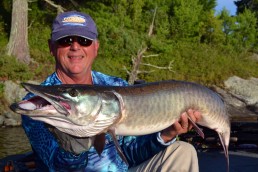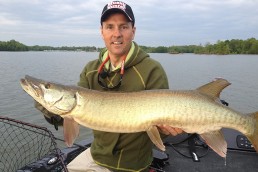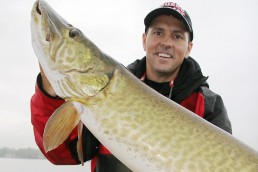Early Fall Topwater Tactics for Muskies
SHARE THIS POST
Early autumn offers up one of the most unique times to test topwater baits, since a lot of muskies are bound to still be up in the shallows. Weed growth has peaked, providing ample shallow cover. Plus, the early transition from summer into fall triggers both baitfish and predators to slide out of deeper, open water up into these weeds and shallow rocks, making them very catchable. Tall, cresting weed tops also provide a high percentage situation for a topwater bait, since many sub-surface lures are bound to collect weeds.
Nearly all big surface baits are bound to fall into one of two categories: 1) fast action lures or 2) slow crawlers. Arguably, these two main categories can be split into several subs. Those that generate a lot of noise and another group that has far less noise, but more action. On top of that, there are surface lures that work perfectly well with a simple straight retrieve and others which demand constant rod manipulation to exploit the lure’s action.
Best topwater for bringing up muskies
My primary fall topwater bait is what many would consider the most popular of all topwater muskie plugs: a prop-style tail-rotator, such as the Topraider; a bait of my own design. It features a rotating tail piece that is activated by simple retrieve speed. The faster you retrieve, the quicker the tail rotation and the more water it sprays. The beauty of this lure style is in its simplicity. Cast it out and reel it in. It works flawlessly. Tail rotator topwater baits also perform well in both calm as well as choppy water conditions, making them extremely versatile. They also match-up well with any partner angler who might be throwing a faster subsurface lure, such as a bucktail or some other in-line spinner, along with just about any form of crankbait. Most of the time, this is a “can’t miss” lure choice.
The key to consistent solid hook-ups with big muskies on this bait, besides keeping very sharp hooks, is in not setting the hook prematurely. Muskies are apt to create a lot of commotion around any surface bait before actually striking it. These baits are no different. Quite often, a big shark-like bulge appears behind the lure. That is indicative of a muskie follow. This might escalate to a sudden charge and strike with a startling explosion. The key is not to set the hook until you actually feel the fish; after it has snatched up the bait. An extra-long rod of 8 feet, or more, also is recommended for this lure, since it can be equally deadly at boatside in the figure 8.
Zigzagging for more strikes
My second choice of topwater bait for autumn muskies is commonly called a zigzag bait, or a walk-the-dawg plug. Most often, these lures are shaped like a big cigar. Unlike the prop-style, tail-rotator surface baits, zigzag lures have no real action on their own and create far less noise. Their main attraction is an erratic action. Zigzag baits generally work best on clear-water muskies that feed more by sight than sound or vibration. They also shine when worked tight near cover, such as fallen trees or thick, emergent weed cover, since these lures can be teased in a tantalizing, lateral manner far more than a tail-rotator bait can.
Are you enjoying this post?
You can be among the first to get the latest info on where to go, what to use and how to use it!
In fact, the biggest strike-triggering advantage zigzag lures have over straight-retrieve topwater baits is their ability to slide up tight to cover for a longer period of time, due to the lateral action. This makes them far superior for casting to shoreline cover or isolated weed clumps in cold fronts. You can work a zigzag surface lure much closer to cover for much longer periods of time. Combine this with an abrupt back-and-forth movement, and you’re sure to trigger a strike response more often in lesser conditions.
I often keep a zigzag lure rigged and ready for a quick cast back to a fish that follows a prop-style surface bait. This has really worked well for me as an immediate change-up lure to a hot fish. I have triggered a number of muskies to pounce on the zigzag action, once I got them fired up on a straight-retrieve, tail-rotator lure. The combination of speed-casting a prop bait to locate the fish and an immediate cast back to the general area with a zig-zag version is a solid gameplan for any fishing trip. It works exceptionally well in the fall.
A one-two punch for bagging a whole bunch
On a final note, both of these topwater bait styles work very well in tandem. The lead angler, casting from the bow, should fish the straight-retrieve tail rotator while the back-deck partner follows up with the zigzag lure. Additionally, both of these lures assist any partner casting a sub-surface muskie plug of any kind. There are a lot of situations where a muskie is bound to ignore the sub-surface bait, yet come roaring in on a topwater plug.
A key trick here, as the follow angler casting from the back of the boat, is to make certain you bomb that surface bait noticeably farther up onto a shallow weedy flat than your partner—including very tight casts to shoreline banks. This allows you to tap into fish that the bow angler can’t reach with a subsurface offering.
Visit Joe’s YouTube channel at fishingwithjoebucher.com. A library of subject-specific videos are available, including one for this article.
MWO
SHARE THIS POST
Did you enjoy this post?
You can be among the first to get the latest info on where to go, what to use and how to use it!
Joe Bucher
Joe Bucher is a Freshwater Fishing Hall of Fame Legendary Angler, book author, lure designer and host of Fishing with Joe Bucher TV series.



